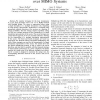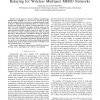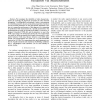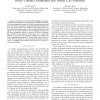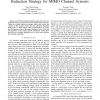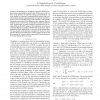GLOBECOM
2008
IEEE
14 years 6 months ago
2008
IEEE
—We consider strategies for the lossy transmission of a zero mean Gaussian source over a 2×2 MIMO channel with Rayleigh fading. The source is represented either using a single d...
GLOBECOM
2008
IEEE
14 years 6 months ago
2008
IEEE
GLOBECOM
2008
IEEE
14 years 6 months ago
2008
IEEE
— In this paper, we propose multiuser multiple-input multiple-ouput (MIMO) one- and two-way relaying protocols. Several wireless MIMO node pairs are establishing either unidirect...
GLOBECOM
2008
IEEE
14 years 6 months ago
2008
IEEE
— Adaptive modulation and antenna diversity are two important enabling techniques for future wireless network to meet demand for high data rate transmission. We study a Markov de...
GLOBECOM
2008
IEEE
14 years 6 months ago
2008
IEEE
Abstract—We investigate the reliability of radio channel simulators in capturing the important properties of radio channels throughout a well-specified environment. Indoor envir...
GLOBECOM
2008
IEEE
14 years 6 months ago
2008
IEEE
Abstract—We consider correlated MIMO multiple access channels with block fading, where each block is divided into training and data transmission phases. We find the channel esti...
GLOBECOM
2008
IEEE
14 years 6 months ago
2008
IEEE
—In this paper, a tap-wise LMMSE channel estimator for MIMO W-CDMA is derived. Descrambling operations applied to delayed versions of the received signal whiten the input signal....
GLOBECOM
2008
IEEE
14 years 6 months ago
2008
IEEE
—An efficient maximum-likelihood decoder with a new reduction strategy is proposed for linear MIMO channel systems. Unlike the current reduction strategies which only reorder th...
GLOBECOM
2008
IEEE
14 years 6 months ago
2008
IEEE
—In many wireless ad-hoc networks it is important to find a route that delivers a message to the destination within a certain deadline (delay constraint). We propose to identify...
GLOBECOM
2008
IEEE
14 years 6 months ago
2008
IEEE
Abstract—In this paper, we investigate cooperative OFDM communications using amplify-and-forward (AF) protocol at the relays, in the presence of imperfect timing synchronization....
